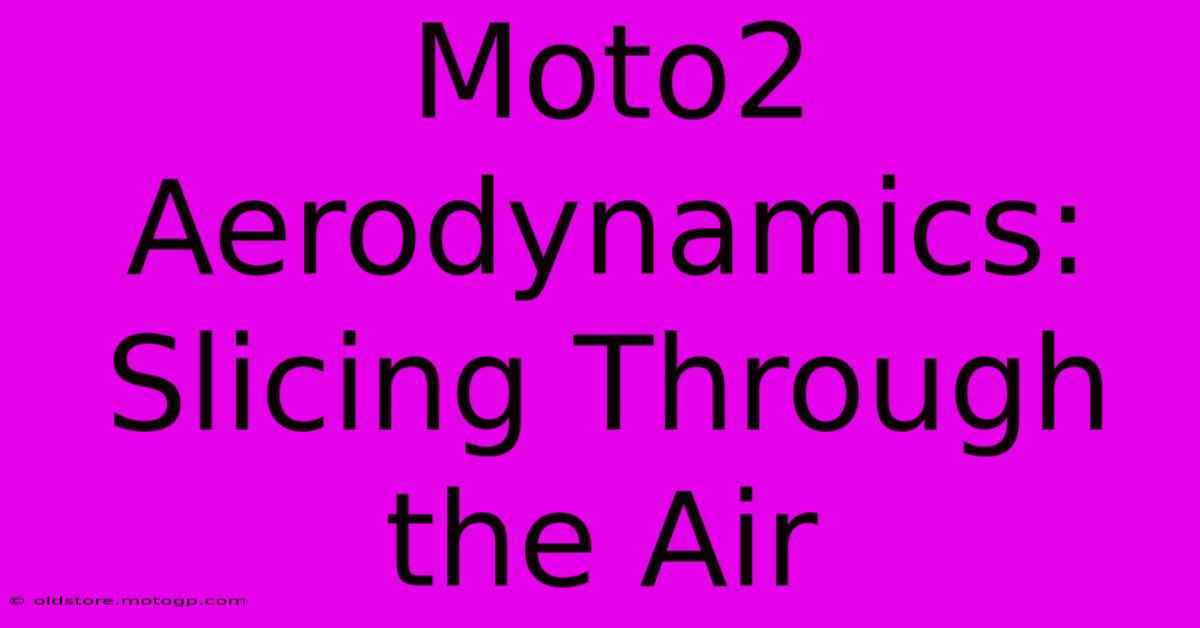Moto2 Aerodynamics: Slicing Through The Air

Table of Contents
Moto2 Aerodynamics: Slicing Through the Air
Moto2 racing is a thrilling spectacle of speed, skill, and precision. While rider talent is paramount, the subtle yet significant role of aerodynamics often goes unnoticed by casual viewers. Understanding how teams optimize their machines for aerodynamic efficiency is key to appreciating the nuances of this fiercely competitive championship. This article delves into the world of Moto2 aerodynamics, exploring the intricate details that separate the frontrunners from the pack.
The Importance of Aerodynamics in Moto2
In Moto2, where horsepower is standardized, aerodynamic efficiency becomes a crucial differentiator. Every tenth of a second gained or lost can mean the difference between victory and defeat. Unlike MotoGP, with its sophisticated and complex aero packages, Moto2 regulations impose stricter limitations, forcing teams to be incredibly ingenious in their aerodynamic solutions. The focus shifts from outright downforce generation to minimizing drag and optimizing airflow around the machine.
Reducing Drag: The Key to Moto2 Speed
Minimizing drag is the primary objective. Drag is the resistance a body experiences as it moves through a fluid (in this case, air). The less drag a Moto2 bike experiences, the faster it can accelerate and maintain higher speeds on straights. Teams achieve this through various strategies:
- Streamlined Fairings: The design of the fairing (the bodywork surrounding the engine and rider) is paramount. Smooth, sculpted surfaces with minimal protrusions are crucial to minimizing turbulence and drag.
- Optimized Rider Position: The rider's posture significantly impacts aerodynamic performance. A tucked position reduces the frontal area presented to the airflow, thus reducing drag. Even minor adjustments in posture can make a difference.
- Aerodynamic Winglets (Limited): While significantly restricted compared to MotoGP, Moto2 still allows for some carefully designed winglets. These are small aerodynamic surfaces designed to manage airflow and potentially generate small amounts of downforce. However, the regulations severely limit their size and complexity.
- Wheel Design: Even the wheels play a role. Careful consideration of their design and the airflow around them can minimize turbulence and reduce drag.
The Subtle Art of Airflow Management
Beyond simply reducing drag, teams strive to manage airflow effectively around the bike. This involves:
- Airflow Separation: Engineers work to prevent airflow separation, a phenomenon where air detaches from the surface of the bike, creating drag and instability. Smooth transitions and carefully designed surfaces help to maintain laminar (smooth) airflow.
- Underbike Aerodynamics: The airflow under the bike is just as crucial as that over it. Properly designed underbody components can help to manage airflow and reduce pressure drag.
- Cooling System Integration: The cooling system for the engine needs to be efficient without causing unnecessary drag. Strategic placement and design of air intakes and outlets are vital.
Innovation and Evolution in Moto2 Aerodynamics
The constant pursuit of aerodynamic advantage drives innovation within Moto2 teams. They continuously test and refine their designs through computational fluid dynamics (CFD) simulations and wind tunnel testing. Even small incremental improvements can translate into significant gains on the track.
While the restrictions in Moto2 prevent the extreme aerodynamic solutions seen in MotoGP, the ingenuity required to extract maximum performance within these constraints is a testament to the skill and expertise of the engineers and teams involved. The battle for aerodynamic supremacy is a hidden but crucial aspect of the Moto2 championship. Understanding this subtle element enhances the appreciation of the breathtaking racing we see on track each weekend.
Keywords: Moto2, Aerodynamics, Drag, Downforce, Fairing, Winglets, Airflow, Wind Tunnel, CFD, MotoGP, Racing Technology, Motorcycle Aerodynamics, Moto2 Technology, Motorcycling.

Thank you for visiting our website wich cover about Moto2 Aerodynamics: Slicing Through The Air. We hope the information provided has been useful to you. Feel free to contact us if you have any questions or need further assistance. See you next time and dont miss to bookmark.
Featured Posts
-
Cota Qualifying Gain A Competitive Advantage
Feb 19, 2025
-
Moto Gp Images The Perfect Way To Celebrate Your Love Of Racing
Feb 19, 2025
-
Unleash Your Inner Racer Racing Motorcycles For Sale
Feb 19, 2025
-
Cota Open Track Days A Bucket List Experience
Feb 19, 2025
-
The F1 Starting Grid How Drivers Prepare Mentally
Feb 19, 2025
